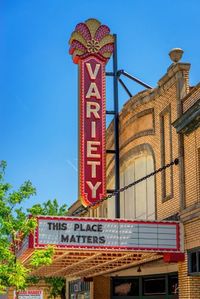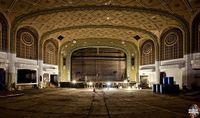Variety Theater
The Variety Theatre in Cleveland, Ohio, is a 2,000-square foot Spanish Gothic vaudeville and movie house that was built by the Variety Amusement Company. With a capacity for 1,900 patrons, the Variety Theatre included a 350-seat balcony, an enormous Kimball Organ, an orchestra pit, and three dressing rooms for stage performances. It opened on Thanksgiving Day in 1927 with the screening of Hula, featuring the notorious sex symbol of the Roaring Twenties, Clara Bow, engaging in such scandalous activities as swimming nude and seducing a married man. Designed by architect Nicola Petti, the Variety featured beautiful cut-glass chandeliers, tapestries, and marble and brass ornamentation, as well as raised plaster decoration on the walls and ceiling. It was the largest theater of its kind west of Ohio’s Cuyahoga River, and it took up an entire city block, incorporating storefronts with shops such as Piggly-Wiggly and the Wurlitzer Company.
Only two years after it opened, the Variety Theatre was bought by Warner Bros. One of the busiest movie theaters on Cleveland's west side, it ran special community promotions such as free Christmas parties for children up to 15-years old, complete with movies and candy. Stars sometimes visited for special events: Lon Chaney Jr. held a late night screening of House of Dracula to raise funds for the local Veterans of Foreign Wars so that residents of a nearby county infirmary could have television sets, and former child star Jackie Cooper visited the manager of the Variety in his new Jaguar in 1951. Save for a tornado that damaged the vertical blade marquee so badly it had to be removed in 1953, most of the drama was purely onscreen. The theater was sold again in 1954 for $500,000 to local realtors and operated by Community Circuit Theaters Company until 1976.
By the time it was sold again to Russell Koz in 1976, the theater was already experiencing some problems brought about by lack of parking and poor repair. In the early 1980s the Variety became a concert venue for metal/punk bands including such greats as R.E.M., Dead Kennedys, Stevie Ray Vaughan, INXS, Metallica, Slayer, and Queensrÿche. The most infamous performance was a Motörhead show in 1984 in which the band played at a face-melting volume of 130 decibels, breaking The Who's previous world record from 1976 and earning the group the nickname "The Loudest Band in the World." The performance was not as popular with management; the volume actually caused plaster to rain down from the ceiling onto the audience. The maintenance man, after several attempts to curtail the incessant encores, wound up pulling the switch on the breaker box, greatly angering Motörhead's lead singer Lemmy Kilmister.
The volume of the performances and the raucous crowds they drew caused friction with neighbors, who filed complaints about noise violations, safety, and loitering. One nearby resident was said to have taped a performance in his living room and played it back for the judge to demonstrate just how disruptive they were. These issues led to the Variety's closure as a theater in 1986 though it remained in use until 1990 as a wrestling gym called the Cleveland Wrestleplex. After that, the Variety Theatre went dark.
The neighborhood around the theater on Lorain Avenue slumped in the years that followed; it was listed as having the highest vacancy rate in the district and clearly could benefit from a rebirth. When Ward 11 Councilwoman Dona Brady joined Cleveland’s City Council in 2005, she prioritized the restoration of the theater. It was both a part of her childhood and part of her plan to link the two bordering neighborhoods that are experiencing an upswing in popularity. The Westown Community Development Corporation formed a nonprofit, Friends of the Historic Variety Theatre, and took over the property in 2009. Patrick Colvin, secretary of the Friends and board president of Westown, was the one who initially let me into the Variety. His commitment to the restoration of the building and the neighborhood around it was immediately striking; “When I first came inside and saw the condition it was in, I cried,” he said. “Sometimes I think I’m crazy for getting involved in such a big project, but I love the building so much.”
Colvin isn’t the only one who loves the Variety. My first trip there was in early March of 2015, and dozens of handmade Valentines cards for the theater and the preservation effort to save it had been taped to the door. Colvin was clearly moved. “I am so much more than just a building,” one card read. “Respect & Love Me.”
While the theater will not be reused for rowdy concerts as some locals have erroneously claimed – Colvin stresses that they are looking to have a harmonious relationship with their neighbors – the space will instead be used for live and catered events and movies. It’s part of a larger plan by Westown to revitalize the neighborhood by introducing trees, art installations, and public furniture in mini parks to the streets. Though it will take an estimated $12-15 million to restore the entire Variety building (including its storefronts and apartments), the Friends have successfully secured some large donations and historic tax credits, which were used to replace the vertical marquee lost over sixty years ago in the tornado. It’s a bold step: literally a 28-foot, 2,280 LED bulb sign letting all who pass it know that the Variety is coming back - breathing life into the district as it does so.
Sources
Chat rooms • What links here • Copyright info • Contact information • Category:Root

